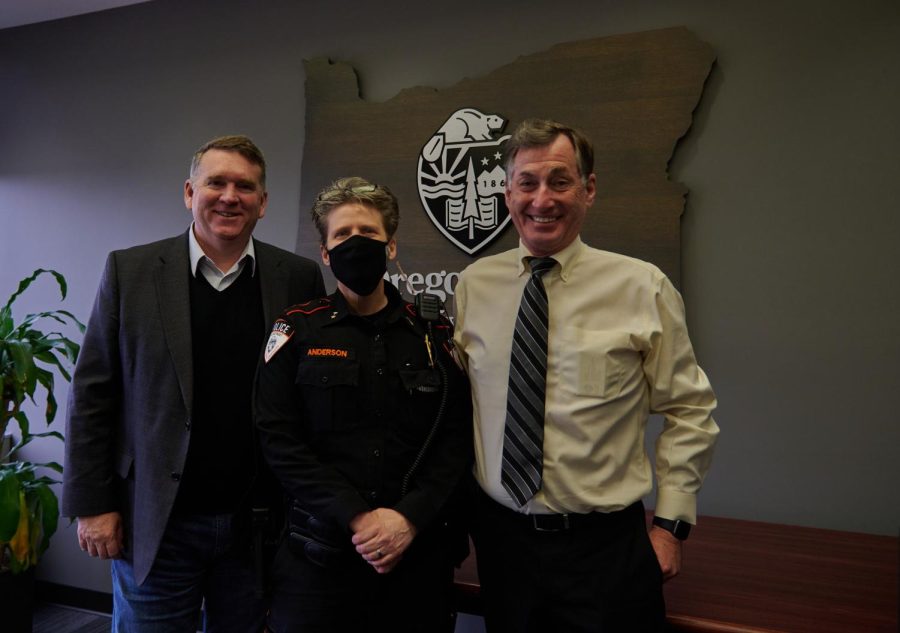OSU pushes personal initiative to prepare for an active threat
Shanon Anderson, Steve Clark, and Paul Odenthal pose together in Corvallis, Ore on Friday, April 21. The trio spoke on Friday about what to do in the case of an active threat on the Oregon State campus.
May 1, 2023
Trigger Warning – story contains mention of gun violence.
Amidst the current mass-shooting epidemic, your personal engagement and preparedness may save a life.
Oregon State University’s administration and the Department of Public Safety hold an active role in preparing for worst case scenarios via staff trainings and engaging in trainings for the community.
The DPS does a variety of preparedness exercises for the OSU community that can be as simple as reading policies and procedures about tactics for enhanced safety.
After an active shooter incident, DPS reviews their own tactics, procedures, what the responding agencies did and how the institutions where the shooting occurred handled the situation.
After reviewing these, DPS officers get together and practice these tactics physically.
In the case of an active shooter on campus there is an emergency action plan – Appendix F – present in each building and on OSU’s emergency management website.
There is a review process for updating the emergency action plans of buildings. The department of emergency management falls under DPS, and they keep track of which buildings need to update and register their emergency action plans.
OSU Police Chief Shanon Anderson also reminds the administration of each OSU building to review the emergency action plan with staff and faculty within the building so they each know what their role is in the event of an emergency.
The DPS conducts in-person training for staff for the buildings that request training.
“Everybody’s role is being familiar with their surroundings, being familiar with what they would do in case this does happen,” Anderson said.
Anderson suggests becoming familiar with your environment each term as each building is slightly different.
“We need every student, every faculty member to understand what they need to do in an active shooter situation,” said Paul Odenthal, administration senior associate vice president. “That is equally if not more important than what Shanon and our team is going to do in response.”
A crucial part of being prepared is becoming familiar with where red emergency phones are located in classrooms to call 9-1-1 or blue emergency phone towers throughout campus that connect you directly to OSU’s dispatch center, according to Anderson.
OSU also provides the Guardian app to text 9-1-1 if you are unable to speak on the phone or reach the red emergency phone in a classroom.
Guardian is an app provided by the Rave system, more commonly known as the OSU Alert System.
The OSU Alert System is the medium that alerts anyone with an OSU email address, communicating via text, email and through the Guardian app.
People can add 3 cell phones, 3 emails or 3 landlines to their account. Parents may sign up for this program with the student email address of their family attending OSU. There is no cost to sign up to the Rave System or the Guardian app.
“One of the things that is really important is to build preparedness, which is different than being paranoid,” Anderson said.
In case of an active shooter, OSU’s website suggests to remain calm and call 9-1-1. During the call, they suggest providing the name and location of the caller and the building where the active shooter is located if known.
If known, the OSU emergency management website asks to provide a description of the race, clothing, type of weapon(s), location last seen, direction of travel and identity of the person(s) to the 9-1-1 operator.
“Students should add their text number to their OSU Alert profile so they can receive alerts on their mobile devices when an incident happens,” said OSU Emergency Preparedness Manager Michael Bamberger. “People will have seconds to learn what is happening and to respond to protect themselves, so receiving the text will inform people what areas to avoid and what to do to protect themselves.”
Evacuating the location where the threat is located is the first step in the Run, Hide, Fight protocol. Anderson says while you run, alert others to evacuate.
If running proves to be a challenge, then the next step is to hide.
“If you are inside the building and the subject – the threat – is immediately in that hallway it may not be safe to run away,” Anderson said.
If this is the case, Anderson suggests hiding and barricading the door, which may look like taking tables to make a funnel to prevent or delay the threat from entering.
If the active threat does enter, the funnel will give an upper hand to the individuals creating the barricade and will have control while the threat attempts to enter. Once they breach the door, it would become time for fighting in the Run, Hide, Fight protocol. This might include making improvised weapons, according to Anderson.
The DPS posts on social media examples of Run, Hide, Fight videos with instructions demonstrating the protocol if there was an active shooter on campus.
“If you think you can safely get out, run. If you can’t get out, then hide.” Odenthal said. “If you are found, then fight.”
Anderson emphasizes that it is Run, Hide OR Fight.
“Not everybody can fight, or it might not be wise at the time to fight,” Anderson said. “It’s an individual decision based on the totality of the circumstances at the time.”
According to Anderson, what matters is that anyone in that situation does something, be it run, hide, fight or a combination of all of the above.
“One of the things that is important to me is that folks know they are not going to be criticized for what they do,” Anderson said.
Odenthal said once the police arrive at the scene, “you need to stay down where you are, you need to be quiet, you need to listen to the instructions of the police.”
When police are at the site, their first priority is stopping the threat and making the scene safe. The standard procedure that follows is to ensure the site is safe with no explosives or other threats, which Anderson warns may be a lengthy process.
“Personal engagement in safety isn’t paranoia … if you see something, say something,” said Steve Clark, OSU’s vice president for university relations and marketing.
Clark encourages the OSU community to immediately contact the DPS if you are concerned about an individual or an object.
“Safety is the number one priority for the university,” Clark said.


















































































![Newspaper clipping from February 25, 1970 in the Daily Barometer showing an article written by Bob Allen, past Barometer Editor. This article was written to spotlight both the student body’s lack of participation with student government at the time in conjunction with their class representatives response. [It’s important to note ASOSU was not structured identically to today’s standards, likely having a president on behalf of each class work together as one entity as opposed to one president representing all classes.]](https://dailybaro.orangemedianetwork.com/wp-content/uploads/2025/03/Screenshot-2025-03-12-1.00.42-PM-e1741811160853.png)

























